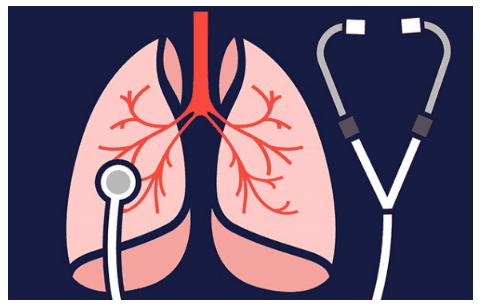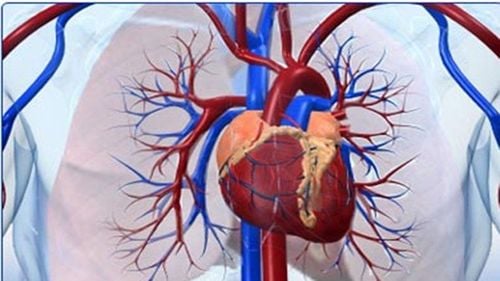This is an automatically translated article.
The article is professionally consulted by Master, Doctor Nguyen Van Anh - Radiologist - Department of Diagnostic Imaging and Nuclear Medicine - Vinmec Times City International Hospital
According to statistics, cor pulmonale is the most common cardiovascular disease after ischemic heart disease and hypertension. Chronic heart disease is very dangerous, so it is necessary to diagnose to have appropriate treatment. Some methods of diagnosing cor pulmonale such as X-ray, echocardiography,... or based on clinical symptoms.
1. What is chronic heart disease?
Bronchiectasis is an enlargement of the right ventricle due to hypertrophy or dilation secondary to a respiratory disease or disorder. Statistically, cor pulmonale is the most common cardiovascular disease after ischemic heart disease and hypertension.
The main cause of bronchial disease is chronic obstructive pulmonary disease, interstitial lung disease or hypoventilation of normal lungs and some other diseases such as myasthenia gravis, muscular dystrophy , kyphosis scoliosis, colloid disease, thromboembolic disease - pulmonary embolism, pulmonary venous disease, primary pulmonary hypertension or people who are overweight or obese.

2. What medical technique is used to diagnose chronic heart disease?
Diagnosis of chronic heart disease based on clinical symptoms:
People with a history of chronic lung disease - thoracic musculoskeletal disease: Right heart failure syndrome: Right heart failure syndrome symptoms include: Shortness of breath, at first dyspnea only occurs in the case of exertion, but then dyspnea even at rest; Cardiovascular symptoms: Cardiovascular symptoms such as tachycardia, apex beat below the sternum, systolic murmur due to functional tricuspid regurgitation. Symptoms of stagnation of peripheral circulation: Signs of symptoms of stagnation of peripheral circulation such as edema of the legs, soft edema, concave pressure. In addition, there are symptoms of less urination, purple lips and extremities, congestion in the sclera with enlarged eyes, enlarged and painful liver, distended jugular veins, positive hepatic-vein feedback. Diagnosis of bronchial heart disease is based on the following subclinical methods:
Electrocardiogram: Signs of right ventricular thickening such as pulmonary emphysema in leads II, III, aVF; axis shift to the right is greater than or equal to 1100; R/S in V6 is less than or equal to 1; rRs in the right precordial leads and right bundle branch block. Straight chest x-ray: If the X-ray image shows an enlarged heart or a teardrop-shaped heart with a prominent pulmonary artery, the diameter of the right pulmonary artery is > 16mm, this is a sign to diagnose chronic heart disease. In addition, it is also possible to see chest deformities such as kyphosis or lung parenchymal damage such as pulmonary fibrosis, alveolar dilation. Echocardiography: With echocardiography method, it will show pulmonary artery pressure > 30 mmHg, right ventricular dilatation. Blood tests: Blood test results show polycythemia vera, increased hematocrit and hemoglobin. Arterial blood gas: In the case of arterial blood gas, the first stage is nothing special, the later stage has chronic respiratory failure.

3. Treatment of chronic heart disease
The main treatment methods for cor pulmonale are as follows:
Have a reasonable diet and rest: Reasonable rest is essential for patients with cor pulmonale; should do light work, when there are signs of heart failure should reduce and do not do strenuous work. In addition, the patient should have a light, low-salt diet; In case of severe heart failure and edema, a stricter paleo diet is required. Oxygen therapy: Oxygen therapy can be given to people with cor pulmonale, but the oxygen should be delivered through a water bottle to keep it moist. With this method, to be effective, it must be used at least 12 hours / 24 hours to reduce mortality and bring patients a relatively comfortable daily life. Drugs to improve ventilation - pulmonary perfusion: Use Bismesialate d'almitrine with an initial loading dose of 50 mg, 1-2 tablets/day for 3 months, then maintenance therapy is required. After the attack, take a break for 1 month and then continue the treatment for 2 months. Treatment of heart failure: Chronic heart disease can lead to total heart failure, so the main treatment for heart failure is a diuretic, then digitale, possibly in combination with nitrate derivatives. Or use stable or improving vasodilators. The effectiveness of the drugs used varies from patient to patient. In addition, some calcium channel blockers such as Nifedipine, Dittiazem can be used... Corticoides: Corticoides are very effective in treating acute exacerbations, using prednisone 5mg orally 4 tablets per day or nebulized dipropionate de. beclomethasone is anti-inflammatory and anti-allergic and reduces secretions.

Antibiotics: Use antibiotics when the patient has signs of bronchopulmonary superinfection. Bacteria that often cause superinfection for patients are Streptococcus pneumoniae, Moraxella catarrhalis, Legionella pneumophila, Staphylococcus aureus.... Exercise therapy: Movement therapy is very important, in which breathing exercises are key. This method increases the expansion of the lungs and thorax, and helps to increase alveolar ventilation, especially diaphragmatic breathing. Eliminate irritants: Trigger factors include alcohol, tobacco, dust, toxic gases. Therefore, it is necessary to quit smoking, stop drinking alcohol and avoid exposure to pollution and dust. In order to accurately diagnose chronic heart disease and have effective treatment methods, patients need to go to a reputable hospital for examination. Currently, Vinmec International General Hospital is one of the leading prestigious hospitals in the country, trusted by a large number of patients for medical examination and treatment. Not only the physical system, modern equipment: 6 ultrasound rooms, 4 DR X-ray rooms (1 full-axis machine, 1 light machine, 1 general machine and 1 mammography machine) , 2 DR portable X-ray machines, 2 multi-row CT scanner rooms (1 128 rows and 1 16 arrays), 2 Magnetic resonance imaging rooms (1 3 Tesla and 1 1.5 Tesla), 1 room for 2 levels of interventional angiography and 1 room to measure bone mineral density.... Vinmec is also the place to gather a team of experienced doctors and nurses who will greatly assist in diagnosis and detection. early signs of abnormality in the patient's body. In particular, with a space designed according to 5-star hotel standards, Vinmec ensures to bring the patient the most comfort, friendliness and peace of mind.
Please dial HOTLINE for more information or register for an appointment HERE. Download MyVinmec app to make appointments faster and to manage your bookings easily.














